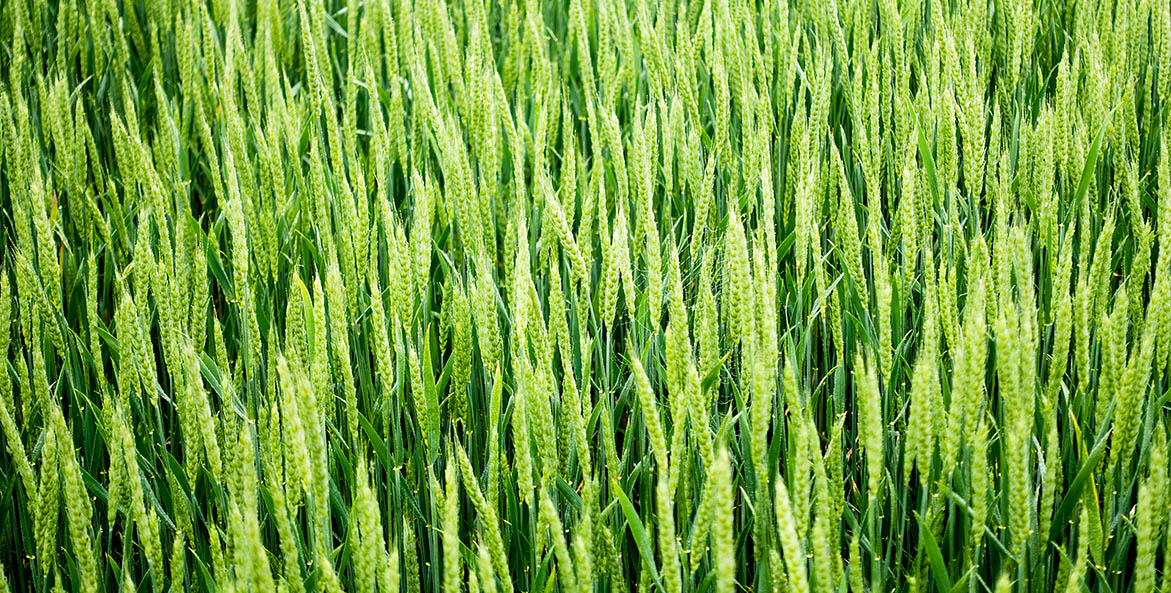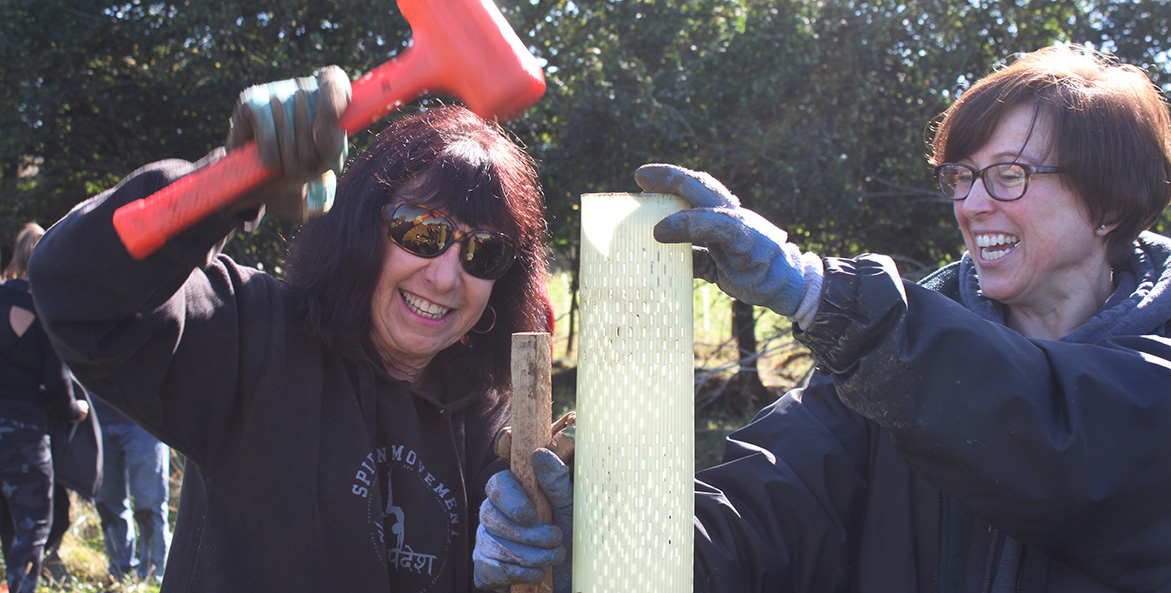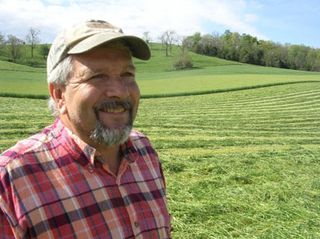Pledge to Stand With the Watershed's Farmers!
Sign Now
Approximately 40 percent of land in the United States, and one-third of the Chesapeake Bay's 64,000-square-mile watershed, is dedicated to farming. It's no wonder then that the way we farm has profound consequences for the health of our communities, our environment, and our local economies.
Farms have the potential to serve as either critical filters or pathways for polluted runoff to our rivers and streams. Currently the agricultural sector has the greatest opportunities to reduce nitrogen, phosphorus, and sediment pollution to the Chesapeake Bay. Agriculture also remains a significant source of climate-warming greenhouse gases, accounting for roughly 10 percent of U.S. emissions annually (Environmental Protection Agency 2021. "Inventory of U.S. Greenhouse Gas Emissions and Sinks 1990-2019").
Conventional agricultural systems often consist of mono-cropping, heavy pesticide and herbicide use, and extensive tillage of the soil. These practices strip nutrients from the soil, erode topsoil, and lead to excess soil erosion and polluted runoff. Instead of acting as a natural sponge and filter for the ecosystem, the land becomes a funnel for fertilizers and pesticides to our rivers and streams. Conventional farming practices have left many operations vulnerable to the effects of climate change, which are already being felt across the Chesapeake Bay watershed. Extreme storms can lead to floods that wash away soil and fertilizers, damaging crops and carrying pollution into waterways. Eroded topsoil also decreases water retention, making farms vulnerable to drought, impacting farm yield and economic viability.
CBF advocates for conservation programs that establish on-the-ground projects that limit polluting runoff while improving farm health: stream buffers, continuous no till, rotational grazing, conservation crop rotation, cover crops, silvopasture, nutrient management, streamside fencing, and other best management practices. These practices also provide co-benefits: increased soil health, sequestered carbon, and improved farm resiliency.
When farming with these intentional practices, agriculture has the potential to not only sustain but regenerate the land, while also injecting money into the economy.
A 2022 CBF report, Agricultural Conservation Practices: Clean Water and Climate Smart Investments, found that fully funding the farm pollution-reduction practices needed to restore the Chesapeake Bay would inject $655 million annually into the region's economy, including $269 million per year in higher earnings for businesses and workers.
Watershed-wide, farmers are adopting these conservation and preservation measures, and they are making progress. But they can't do it alone. Federal and state government investments in conservation practices, like programs contained in the federal Farm Bill, are crucial to helping farmers reduce pollution, remain profitable, and improve water quality for everyone.
Retaining farmland is critical for the future of the Chesapeake Bay watershed. We're losing agricultural land to sprawling suburban development and ill-conceived solar sites, diminishing profits, increases in the cost of fuel and other operational expenses, and a steep decrease in the share of consumer food dollars received by farmers. Preserving farms and open space is essential, because when farmed regeneratively, these lands serve as precious natural filters for our water. CBF supports land use programs and policies that slow the loss of farmland to development and prevent sprawl.
Be sure to check out our series of farmer success stories across the watershed.

Rye grows at the The Bishop Claggett Center in Buckeystown, Maryland. Grains such as rye or wheat are useful winter cover crops that hold soil in place, protecting land from erosion by water and wind.
Will Parson/Chesapeake Bay Program
Regenerative Agriculture
Regenerative agriculture describes holistic farming systems that, among other benefits, improve water and air quality, enhance ecosystem biodiversity, produce nutrient-dense food, and store carbon to help mitigate the effects of climate change.
The top five principles of regenerative agriculture include:
- Minimize the physical, biological, and chemical disturbance of the soil.
- Keep the soil covered with vegetation or natural material.
- Increase plant diversity.
- Keep living roots in the soil as much as possible.
- Integrate animals into the farm as much as possible.
These farm systems are designed on ecologically sound principles to work in harmony with nature, while also maintaining and improving economic viability and farm resiliency.
Some examples of key regenerative agricultural practices include streamside forest buffers, converting cropland to pasture and rotational grazing, continuous no-till, conservation crop rotation, cover crops, silvopasture, nutrient management, and streamside fencing. Learn more about these practices.
While regenerative agriculture has gained attention in recent years, these concepts and practices are not new, but based on the knowledge and farming experience of indigenous communities.
Agricultural Equity
Just as biodiversity is vital to healthy ecosystems, diversity among people in conservation efforts is essential. Engaging people of all walks of life will help implement a robust variety of inventive, creative solutions to resolve many of our environmental and economic challenges. Black, Indigenous, and People of Color (BIPOC) farmers historically were some of the original regenerative agricultural practitioners, but decades of systemic barriers blocked pathways to land ownership, unequal access to support programs and services.
Success in farming depends on access to land, capital, technical assistance, and other support programs. Farming has always been an economically challenging occupation for all, but immigrant, refugee, tribal, and BIPOC communities, face much greater social and institutional barriers to owning and operating farms successfully.
Agricultural equity opportunities are found both in traditional agricultural communities as well as urban communities.
What CBF Is Doing

Every year, CBF and volunteers plant thousands of trees alongside streams on farms across the watershed.
Codi Yeager/CBF Staff
Advocacy and Restoration
Agricultural conservation practices are some of the most cost-effective solutions to address pollution, providing multiple environmental and societal benefits. Practices that focus on building healthy soils and maintaining permanent vegetation can reduce pollution, actively remove carbon from the atmosphere, and improve the land's ability to withstand floods, drought, and other extremes linked to climate change.
Planting trees alongside streams is one incredibly effective way to keep pollution out of rivers and streams and aid streams in cleaning nutrients from the water. This practice forms what is known as a “forested riparian buffer” and when implemented on farms, greatly reduces the amount of agricultural waste in our waterways. Each spring and fall, CBF plants thousands of trees in an effort to keep farm pollution out of the bay.
CBF advocates for strong federal and state agricultural cost-share programs that provide funding for farmers to make these important upgrades by providing them with critical financial and technical support.
CBF supports opportunities to assist historically disadvantaged farmers in the region to implement agricultural practices to improve water quality, climate resilience, soil heath and farmers' economic wellbeing.
Promoting Soil Health and Rotational Grazing
Increasing soil health has the dual benefits of reducing polluted runoff and sequestering carbon. CBF funds programs and initiatives that cultivate healthy soil throughout the watershed by promoting principles such as maximizing cover, minimizing soil disturbance, and increasing biodiversity. Practices that embody these principles include cover cropping, low or no tillage, diverse crop rotation, and integrating livestock for rotational grazing. Rotational grazing involves frequently moving livestock between multiple pastures, which allows plants time to regenerate. Build organic matter, and create healthier soil. CBFs' programs connect current and new grazing farmers and provides farmer-to-farmer mentoring, on-farm demonstrations, and other peer-to-peer experiences.
Modeling Regenerative Agriculture
Located in Prince George's County, Maryland, CBF's Clagett Farm is a 238-acre working farm, that practices regenerative agriculture to demonstrate the benefits it has on soil health, food, and water quality. The farm has a 20-acre organic vegetable operation, grass-fed beef cattle and sheep, and a native tree nursery.
Connecting People to Healthy Food
CBF manages the Buy Fresh Buy Local Chesapeake chapter, which helps consumers, sustainable farms, and businesses connect, supporting the production and distribution of sustainably produced food that is healthy for the people, the land, and the Chesapeake Bay.
Providing Agricultural Equity Resources
In conjunction with our on-the-ground efforts, CBF has also developed resource guides for beginning farmers in Pennsylvania and Maryland for finding assistance with loans, marketing, business development, conservation funding, equipment, and other needs.
What You Can Do
Buy Local
Supporting farmers that are implementing environmentally sound and beneficial practices is a great way to make your consumer dollars have an impact. Supporting local farms also has the potential to decrease the environmental footprint of your food. Wondering where to start? Check out our Buy Fresh Buy Local Food Guide.
Volunteer
Help at CBF's Clagett Farm
Want to get your hands dirty while learning about regenerative agriculture? From May through November, volunteers are welcome to help plant, weed, and harvest. See our calendar for available dates and information.
Attend a Tree Planting
Each spring and fall, CBF plants thousands of trees in an effort to keep farm pollution out of the bay. Learn more about upcoming tree plantings and how you can join us on our events calendar.
Support a Bay-Friendly Farm Bill
Passed only once every five years, the federal Farm Bill is a package of legislation that has far-reaching impacts on the way food is grown, and the health of our communities and our waterways. Farmers across the watershed have used the Farm Bill conservation programs to convert to more environmentally friendly practices, bringing them healthier soil and increasing their bottom lines. Learn more on our Farm Bill page.



